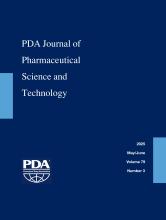Abstract
Microbiological contamination may cause microbial proliferation and consequently additional problems for pharmaceutical companies through production stoppage, product contamination, investigations of process deviations, out-of-specification results and product disposal. This is one of the major concerns of the regulatory health agencies. Microbiological load (bioburden) may represent a potential risk for patients if the sterilization process is not effective and/or due to the production of toxins. Although bioburden can be eliminated by terminal sterilization or filtration processes, it is important to monitor the amount and determine the identity and characteristics of the microorganisms present prior to final processing. The application of microorganism identification systems is crucial for identifying the type of contamination, which can be extremely useful for investigating. The aim of this study was to evaluate the profiles of microorganisms identified in bioburden assays from solutions, culture medias, and products (SCP) from a pharmaceutical industry facility. From 2018-2020, a total of 1,078 samples from 857 different lots of SCP were analyzed and isolated microorganisms were identified. A prefiltering step was included after March 2020, in order to reduce the bioburden before sterilizing filtration. Criteria for the definition and management of microorganisms identified were evaluated after an integrative bibliographic review, and three groups were proposed (critical, objectionable, and nonobjectionable microorganisms). For the samples that did not include prefiltering (n=636), 227 (35.7%) presented microbial growth. For those that included prefiltering, before prefiltering (n=221), 60.6% presented microbial growth, and after prefiltering, this value was reduced to 4.1%, which can be attributed to a contamination during the sampling or a wrong filtering. From the samples that presented microbial growth, 678 microorganisms were identified as bacteria and 59 as molds and yeasts. A total of 120 microorganisms (56 and 27 Gram-positive and negative bacteria, respectively, 31 yeasts, and six filamentous molds) could not be identified, and the remaining microorganisms were classified as objectionable (n=507; 82.2%), nonobjectionable (n=103; 16.7%) and critical (n=7; 1.1%). Most of the bioburden species (>80.0%) were considered objectionable microorganisms. A process for classification and management of bioburden analysis results based on a literature review of pathogenic and physiological characteristics of the microorganisms was proposed.
- Pharmaceutical facility
- bioburden
- contamination control strategy
- identification
- microbial contamination
- quality control
- Received July 26, 2023.
- Accepted June 11, 2024.
- Copyright © 2024, Parenteral Drug Association
PDA members receive access to all articles published in the current year and previous volume year. Institutional subscribers received access to all content. Log in below to receive access to this article if you are either of these.
If you are neither or you are a PDA member trying to access an article outside of your membership license, then you must purchase access to this article (below). If you do not have a username or password for JPST, you will be required to create an account prior to purchasing.
Full issue PDFs are for PDA members only.
Note to pda.org users
The PDA and PDA bookstore websites (www.pda.org and www.pda.org/bookstore) are separate websites from the PDA JPST website. When you first join PDA, your initial UserID and Password are sent to HighWirePress to create your PDA JPST account. Subsequent UserrID and Password changes required at the PDA websites will not pass on to PDA JPST and vice versa. If you forget your PDA JPST UserID and/or Password, you can request help to retrieve UserID and reset Password below.






